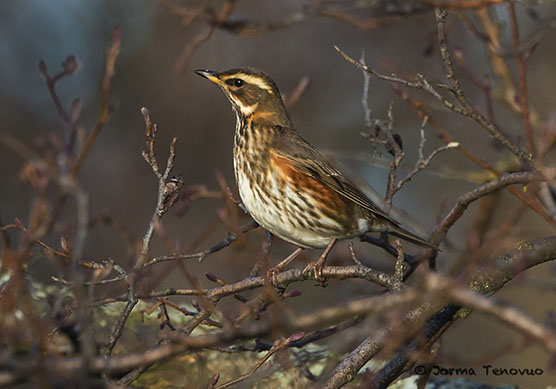Press release 2016-01-11 at 13:13

The redwing seems to be adversely affected by climate change and its range has shifted towards the north. Photo by Jorma Tenovuo.
Many of the bird species native to Finnish forests have declined in recent decades. According to a newly published study, the total number of nesting pairs in the southern Finnish managed forest area has declined by approximately 18 per cent over the last 22 years. The population decline of some species, such as the willow warbler and the redwing, has been primarily the result of climate change, while other species, such as the chaffinch and the Eurasian siskin, have declined primarily due to forestry. In the case of the willow tit, the decline has been caused by the combined effect of both climate change and forestry. The two species that have managed to increase their numbers, namely the great tit and the blue tit, are common southern species that benefit from climate change and human activity in many ways.
Many of the most common bird species found in Finnish forests have declined in recent decades. The reasons behind this decline have not yet been fully determined. The aim of the newly published study was to examine the extent at which population changes are caused by climate change, and the extent at which they are caused by forestry or other human activities. The population changes of different species in managed forests were studied based on bird censuses conducted at the same locations yearly in 1993–2015. The results were then compared to bird censuses conducted in protected areas.
Climate change and forestry reduce the diversity of forest birds
In the managed forest area, the total number of nesting pairs declined by 18 per cent between 1993 and 2015, or nearly one per cent per year (0.9%). Out of the 12 most abundant bird species, seven declined, four did not show any changes and one increased. Out of the declined species, the chaffinch, the Eurasian siskin and the goldcrest did not decline in protected areas. The decline of these species in managed forests was caused primarily by the clearcuts of old spruce-dominated forests, as these are the species' preferred habitats.
"Three of the species that showed a decline in managed forests, namely the willow warbler, the redwing and the tree pipit, also declined in protected areas, most likely due to climate change. These species have previously benefited from the logging of old forests and thrived in the young or thinned forests created as a result of logging. The mean weighted latitude of density of these species has also shifted towards the north as a result of climate change," states Leading Researcher Raimo Virkkala from the Finnish Environment Institute.
The willow tit showed a strong decline in both managed forests and protected areas, and the species' decline is connected to both forestry and climate change. The redwing and the willow tit have also declined in other parts of Europe. As a result they have been classified as threatened species in the European Red List, under the vulnerable category.
The great tit was the only one of the most abundant species that showed a clear increase in managed forests. The blue tit also showed a strong increase during the study period, becoming one of the most abundant forest bird species during the latter years of the study. The great and the blue tit are both southern species, which have benefited from human activity and climate change in many ways. The winter survival of the great and blue tit has improved thanks to increased winter feeding. In addition, the eutrophication of forests benefits the great and the blue tit, which can also nest in the holes of retention aspen trees.
The study was published in the Biodiversity and Conservation journal: Virkkala R. 2016: Long-term decline of southern boreal forest birds: consequence of habitat alteration or climate change? Biodiversity and Conservation
More information
Leading Researcher, Docent Raimo Virkkala, Finnish Environment Institute, firstname.lastname@ymparisto.fi, tel. +358 (0)295 251 747